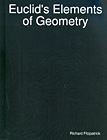- About MAA
- Membership
- MAA Publications
- Periodicals
- Blogs
- MAA Book Series
- MAA Press (an imprint of the AMS)
- MAA Notes
- MAA Reviews
- Mathematical Communication
- Information for Libraries
- Author Resources
- Advertise with MAA
- Meetings
- Competitions
- Programs
- Communities
- MAA Sections
- SIGMAA
- MAA Connect
- Students
- MAA Awards
- Awards Booklets
- Writing Awards
- Teaching Awards
- Service Awards
- Research Awards
- Lecture Awards
- Putnam Competition Individual and Team Winners
- D. E. Shaw Group AMC 8 Awards & Certificates
- Maryam Mirzakhani AMC 10 A Awards & Certificates
- Two Sigma AMC 10 B Awards & Certificates
- Jane Street AMC 12 A Awards & Certificates
- Akamai AMC 12 B Awards & Certificates
- High School Teachers
- News
You are here
Euclid's Elements of Geometry

Publisher:
Lulu
Publication Date:
2012
Number of Pages:
544
Format:
Hardcover
Price:
31.26
ISBN:
9780615179841
Category:
Monograph
[Reviewed by , on ]
Fernando Q. Gouvêa
10/9/2012
I’m very happy that this book exists and glad to have a copy. Alas, I’m probably in the minority.
This is an edition of the Elements that includes the complete Greek text and a new English translation. The text is presented in two columns, Greek and English. The book has been published by the author through lulu.com, and it shows the usual problems of self-published texts. The book is big (probably to allow printing on standard letter-size paper, without trimming), and therefore difficult to handle and to shelve. The margins are too small, and the font used for the Greek text is light and somewhat difficult to read.
One can overlook such faults if the content is worthy. For someone like me, the usefulness resides in having the Greek and English side-by-side. I’m one of those dangerous people with “a little knowledge.” I can barely read Greek, but can make out things here and there, and I’ve learned to be suspicious of translators. So having the two languages easily accessible for comparison is great.
Most potential readers, however, are likely to be either people who want to read Euclid in English or classicists working with the Greek text. And in each case there isn’t enough here.
The Greek text is the standard one, established by Heiberg and originally published by Teubner. This text is now in the public domain and is available online, allowing Fitzpatrick to include it here. He does not include any of Heiberg’s textual notes and other material. The figures are also the standard ones found in Heiberg.
Fitzpatrick’s new English translation is (perforce) not too different from the standard translation by Heath. For comparison purposes, here is the famous definition 5 in book V:
Heath: Magnitudes are said to be in the same ratio, the first to the second and the third to the fourth, when, if any equimultiples whatever be taken of the first and third, and any equimultiples whatever of the second and fourth, the former equimultiples alike exceed, are alike equal to, or alike fall short of, the latter equimultiples respectively taken in corresponding order.
Fitzpatrick: Magnitudes are said to be in the same ratio, the first to the second and the third to the fourth, when equal multiples of the first and the third either both exceed, are both equal to, or are both less than, equal multiples of the second and the fourth, respectively, being taken in corresponding order, according to any kind of multiplication whatever.
Fitzpatrick appends a note explaining this in modern notation:
In other words, α:β::γ:δ if and only if mα > nβ whenever mγ > nδ and mα = nβ whenever mγ = nδ and mα < nβ whenever mγ < nδ, for all m and n. This definition is the kernel of Eudoxus’ theory of proportion, and is valid even if α, β, etc. are irrational.
Heath’s original edition includes a long discussion of this definition, of course, but an edition reproducing only the text of Heath would not include any explanation. Clearly Fitzpatrick’s English is a little more modern and colloquial than Heath’s, but the difference is small. Most specialists consider Heath’s translation perfectly adequate, so I think my recommendation for those who want an English Euclid would still be the beautiful edition from Green Lion Press.
The consensus on Heath’s translation does not extend to his notes. Scholarship has progressed, and Heath’s annotations are now to be treated with great suspicion. He is at best unreliable, and at worst downright misleading. An English reader who wants more than just a straight translation (and I suspect most readers do) currently has nowhere to go. Fitzgerald does include sparse notes, but not enough to make him better than other editions.
Scholars, on the other hand, will usually want the Greek text with all the textual apparatus. Heiberg includes all his in his edition, of course. Alas, Teubner seems to have allowed it to go out of print, meaning that scholars might be able to use a new edition or a reprint of Heiberg’s. The raw text without the surrounding information, however, will not suffice, and once again Fitzgerald’s offering doesn’t quite work.
Another scholarly desire is an edition of Euclid that pays proper attention to how the figures appear in the available manuscript texts. Heiberg redrew all his figures with modern tools, and that’s what we get here too, but there is great interest in knowing (to the extent we can!) what the figures were like in the original and early copies.
So Fitzgerald’s edition falls somewhat between two stools: not quite what the scholars need, not quite what the average reader wants. But I’m glad I have it.
Fernando Q. Gouvêa is Carter Professor of Mathematics at Colby College in Waterville, ME. He is the author, with William P. Berlinghoff, of Math through the Ages.
The table of contents is not available.
- Log in to post comments




